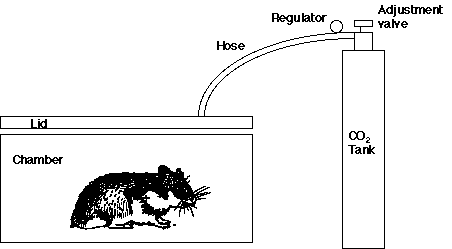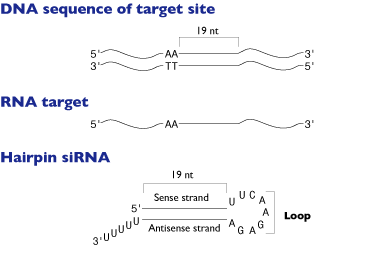Euthanasia Guidelines
互联网
Animals are normally euthanized at the end of a study for the purpose of sample collection or post-mortem examination. Animals may be euthanized because they are experiencing pain or distress. Euthanasia is defined as a pain-free or stress-free death. The IACUC has approved certain methods for humanely killing animals that meet the definition of euthanasia. The appropriateness of the method may vary from species to species. These guidelines are adapted from the report of the Americal Veterinary Medical Association Panel on Euthanasia , J Am Vet Med Assoc 2007.. The American College of Laboratory Medicine has issued a report on rodent euthanasia that has many useful references and guidelines.
Investigators or technicians who require advice or assistance on proper techniques of euthanasia may contact RAR .
NOTE: You may only use a euthanasia method that is approved in your IACUC Animal Care and Use Protocol. A change in euthanasia method, including dose or route of administration, is a significant change in protocol and must be reviewed and approved by the IACUC before implementation.
pain or discomfort in the animals).
- Weight loss : loss of 20-25% (depending on attitude, weight recorded at time of arrival, and age: growing animals may not lose weight, but may not gain normally) or if not measured, characterized by cachexia and muscle wasting.
- Inappetance : complete anorexia for 24 hours in small rodents, up to 5 days in large animals; partial anorexia (less than 50% of caloric requirement) for 3 days in small rodents, 7 days in large animals.
- Weakness/inability to obtain feed or water : Inability or extreme reluctance to stand which persists for 24 hours, assuming that the animal has recovered from anesthesia.
- Moribund state : depression coupled with body temperature below 99 F, or non-responsive to stimulation, assuming that the animal has recovered from anesthesia.
- Infection : infection involving any organ system (either overt, or indicated by increased body temperature or WBC parameters) which fails to respond to antibiotic therapy within an appropriate time and is accompanied by systemic signs of illness.
-
Signs of severe organ system dysfunction non-responsive to treatment, or with a poor prognosis as determined by an RAR veterinarian :
Respiratory : dyspnea, cyanosis.
Cardiovascular : blood loss or anemia resulting in hematocrit below 20%; one transfusion may be performed.
Gastrointestinal : severe vomiting or diarrhea, obstruction, intussuception; peritonitis, evisceration (immediate euthanasia required).
Urogenital : renal failure characterized by elevated BUN, creatinine or uroperitoneum.
Nervous : CNS depression, seizures, paralysis of one or more extremities; pain unresponsive to analgesic therapy.
Musculoskeletal : muscle damage, bone injury, locomotor defecits, etc. resulting in inability to use the limb, unless anticipated as part of the study.
Integumentary : Non-healing wounds, repeated self-trauma, second or third degree heating pad burns.
Only one major surgical procedure (involving entry of abdomen or thorax) may be performed per animal, unless indicated on an approved protocol. Therefore, major surgery intended to correct complications arising after a major experimental procedure is not permitted without prior approval. In such cases, euthanasia must be performed. Procedures such as repair of dehiscences and wound cleaning/debridement for treatment of infection may be performed following notification of the RAR veterinary staff.
| Method | Animals under 125 g | Rabbits/Rodents over 125 g under 1 kg | Rabbits/Rodents over 1 kg under 5 kg | Birds | Dogs | Cats | Nonhuman Primates | Farm Animals (e.g. swine, ruminants and horses) | Reptiles | Amphibians3 /Fish |
|---|---|---|---|---|---|---|---|---|---|---|
| CO2 | A | A4 | A4 | A | UNA | UNA | UNA |
A5 UNA |
A | A |
| Barbiturate Overdose/ Euthanasia Solution, Intraveneous (100 mg/kg) | A | A | A | A | A | A | A | A | A | A |
| Barbiturate Overdose/ Euthanasia Solution, Intraperitoneal (100 mg/kg) | A | A | A | A | UNA | A | UNA |
A6 UNA |
A | A |
| Anesthesia and Exsanguination | A | A | A | A | A | A | A | A | A | A |
| Anesthesia and Intraveneous KCl (1-2 meq/kg) | A | A | A | A | A | A | A | A | A | A |
| Anesthesia and Decapitation | A | A | AWJ | A | UNA | UNA | UNA | UNA | A | A |
| Anesthesia and Cervical Dislocation | A | A | UNA | A | UNA | UNA | UNA | UNA | N/A | N/A |
| Decapitation of Awake Animal | AWJ1 | AWJ | AWJ | AWJ1 | UNA | UNA | UNA | UNA | AWJ | AWJ |
| Cervical Dislocation of Awake Animal | AWJ 2 | UNA | UNA | AWJ1 | UNA | UNA | UNA | UNA | N/A | N/A |
| Other | Stunning or electrocution followed by exsanguination may be used for on-farm or slaughterhouse euthanasia. Rifle shot may be used for field euthanasia where restraint is not possible. | A- Immersion in MS-222 (tricaine) or benzocaine at 2 g/L water |
Volatile agents used to euthanize animals should not be stored or used in animal rooms because of improper ventilation, toxicity to laboratory animals, and possible effects on experimental results.
Chloroform is not acceptable for either anesthesia or euthanasia as it is very toxic to many species of mice. Additionally, this compound has been shown to be carcinogenic.
Ether is irritating, flammable and explosive, and should not be used in animal rooms. In addition, animals euthanized with ether must be left in a fume hood for several hours so that the carcasses are not explosive when disposed of. Precautions on ether use are available from DEHS .
Chloral hydrate and alpha chloralose used as sole agents are not adequate to reliably achieve euthanasia
Abbreviations :
- A = Acceptable
- AWJ = Acceptible only with scientific justification , in writing, on the Animal Usage Form, that another methods would interfere with the goals of the experiment
- UNA = Unacceptable
- N/A = Not applicable or not specifically addressed by the IACUC
- Always UNACCEPTABLE in awake animals : KCl, MgSO4, strychnine, neuromuscular blocking agents, exsanquination, air embolism, freezing and chloroform (due to its hazards to personnel).
3 Amphibians may also be double-pithed
4 It is recommended that rabbits not be euthanized by CO2 inhalation because of difficult induction.
5 Swine <40 kg may be euthanized with CO2 in an appropriate chamber.
6 Neonatal swine may be euthanized by IP barbiturate injection.
USE OF THE CO2 CHAMBER FOR EUTHANASIA OF RODENTS
- Its heart is beating, check this by feeling the chest between your thumb and forefinger.
- It blinks when you touch the eyeball.






